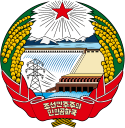- Congress of the Workers' Party of Korea
-
North Korea 
This article is part of the series:
Politics and government of
North Korea
- Eternal President
- Supreme Leader
- Supreme People's Assembly
- Chairman of the Presidium
- National Defence Commission
- Chairman
- First Vice Chairman
- vacant
- Government
The Congress of the Workers' Party of Korea (조선로동당 당대회) is the highest body of the Workers' Party of Korea, according to Party Rules.
The WPK Congress hears the reports of central authorities, makes amendments to Party Rules, sets the Party's political line, and elects the WPK Central Committee as well as the Party General Secretary[1].
The WPK Congress was scheduled to meet every five years, though this deadline was not always observed. After no congress had taken place since 1980, the September 2010 WPK Conference changed the Party Rules eliminating the clause concerning the five years, as well as transferring many of the Congress powers to the Party Conference (including the one of electing top officials and changing Party Rules)[1].
Contents
1st Congress
- Date: 28–30 August 1946
- Delegates: 801
- Party members: 366,339 (4% of population)
Also called the Inaugural Congress of the Workers' Party of Korea, it established the Workers' Party of North Korea from the North Korean Bureau of the Korean Communist Party.
The WPNK 1st Central Committee held 12 plenary meetings from 1946 to 1948. The 1st Plenum on 30 August 1946 elected Kim Tu-bong as Chairman, Kim Il-sung and Chu Nyong-ha as Vice Chairmen, and appointed a 5-member Political Committee and 15-member Standing Committee.
2nd Congress
- Date: 27–30 March 1948
- Delegates: 999
- Party members: 725,762 (8% of population)
The Congress focused on the goal of achieving the country's reunification. Kim Il-sung attacked the Pak Hon-yong-led "domestic faction".
Later, on 30 June 1949, the party merged with the Workers' Party of South Korea giving birth to the unified Workers' Party of Korea.
The WPNK 2nd Central Committee held 6 plenary meetings from 1948 to June 1949; the WPK Central Committee held 11 plenary meetings from June 1949 to 1956, on yearly and later two-year basis. The 2nd Plenum on 12 July 1948 decided upon the establishment of the Democratic People's Republic of Korea. The unified Central Committee's 1st Plenum on 1 July 1949 elected Kim Il-sung as Chairman, with Pak Hon-yong and Ho Ka Ai as Vice Chairmen.
3rd Congress
- Date: 23–29 April 1956
- Delegates: 916
- Party members: 1,164,945 (10% of population)
This was the first congress to be held after the Party's unification, the establishment of the DPRK and the Korean War. The Congress decided upon the objectives of the Five-Year Plan for the Development of the National Economy (1957–1961). Inner fighting resumed as a result of the 20th Congress of the CPSU. Kim Il-sung's opponents Pak Chang-ok and Choe Chang-ik were later expelled.
The WPK 3rd Central Committee held 14 plenary meeting from 1956 to 1961. The 1st Plenum on 29 April 1956 appointed Kim Il-sung as Chairman, with five Vice Chairmen; the Political Committee was abolished and a 15-member Standing Committee was elected, and an Organizational Bureau was established.
4th Congress
- Date: 11–18 September 1961
- Delegates: 1,657
- Party members: 1,311,563 (12.2% of population)
Kim Il-sung delivered a report outlining the programme of the "First Seven-Year Plan for the Development of the National Economy (1961–1967)". He also urged party members to "oppose revisionism, factionalism, parochialism and nepotism, and defend the unity of the Party", as a result of the WPK moving to a more international independent stand.
The WPK 4th Central Committee held 20 plenary meetings from 1961 to 1970. The 1st Plenum on 18 September 1961 appointed Kim Il-sung as Chairman and other five (including Choi Yong-kun and Kim Il) as Vice Chairmen; the Political Committee was restored with 15 members. The Orburò was abolished.
After a Party Conference in October 1966 greatly changed the structure of the WPK, the 14th Plenum (12 October 1966) appointed Kim Il-sung as General Secretary and elected a 20-member Political Committee (with Kim Il-sung and former vice-chairmen as Presidium members) as well as a 10-member Secretariat.
5th Congress
- Date: 2–13 November 1970
- Delegates: 1,734
- Party members: 1.6 millions (13% of population)
Kim Il-sung delivered a report setting the "three revolutions" (ideological, technological and cultural revolutions) as well as the "Six-Year National Economic Plan (1971-1976)".
The WPK 5th Central Committee held 19 plenary meetings from 1970 to 1980. The 1st Plenum on 13 November 1970 appointed Kim Il-sung as General Secretary, a 15-member Political Committee and a 9-member Secretariat. The 8th Plenum in February 1974 designated Kim Jong-il as Kim Il-sung's successor.
6th Congress
- Date: 10–14 October 1980
- Delegates: 3,320
- Party members: 3 millions estimated (17% of population)
Kim Il-sung delivered a report defining "modelling of the whole society on the Juche idea" as the general task of the Korean revolution and proposing the Democratic Federal Republic of Koryo between the DPRK and South Korea. Party Rules were changed dropping references to Marxism-Leninism in favour of Juche. Kim Jong-il as announced as Kim Il-sung's heir.
The WPK 6th Central Committee held 21 plenary meetings from 1980 to 1993, and did not meet again until 2010. The 1st Plenum on 14 October 1980 appointed Kim Il-sung as General Secretary, a 34-member Politburo (with Kim Il-sung, Kim Jong-il, Kim Il, O Chin-u and Li Jong-ok as Presidium members) and a 9-member Secretariat.
After the September 2010 Party Conference massively renewed the Central Committee membership, the 28 September 2010 Plenum elected a new 32-member Politburo (with Kim Jong-il, Kim Yong-nam, Choe Yong-rim, Jo Myong-rok and Ri Yong-ho as Presidium members) and 10-member Secretariat.
See also
References
Categories:- Government of North Korea
- Political party assemblies
Wikimedia Foundation. 2010.
